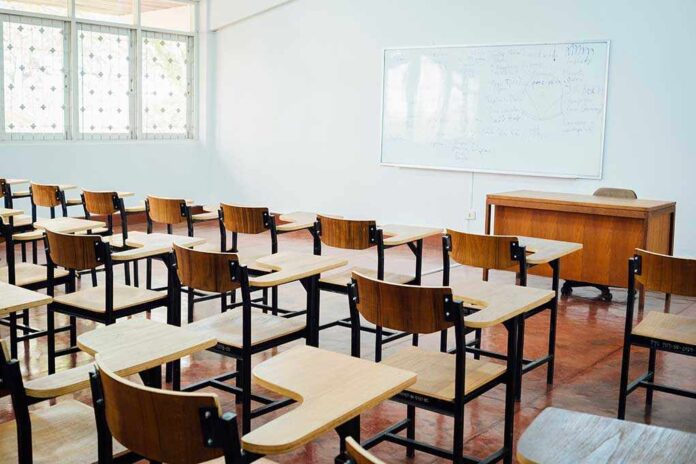Post-COVID absenteeism rates among low-income students have skyrocketed by 89% since 2019, with disadvantaged children continuing to miss school at alarming rates while education officials struggle to reverse the devastating trend.
Key Takeaways
- Chronic absenteeism has more than doubled from 17% in 2019 to 37% in 2023 in states like North Carolina, Texas, and Virginia, creating a new educational crisis.
- Low-income students are disproportionately affected, with income disparities—not racial factors—being the primary driver of attendance gaps.
- Despite decreasing from a peak of 28% in 2022 to 23% in 2023, national absenteeism rates remain significantly higher than pre-pandemic levels.
- Traditional interventions like home visits and incentive programs have proven largely ineffective in addressing the root causes of post-pandemic absenteeism.
- Some COVID-era educational adaptations, including relaxed graduation requirements and expanded online learning options, may have inadvertently contributed to the persistent absenteeism problem.
The Widening Attendance Gap
The COVID-19 pandemic’s educational legacy continues to plague American schools, with chronic absenteeism—defined as missing more than 10% of the school year—becoming a persistent crisis. Attendance data reveals an alarming trend: by 2022, national chronic absenteeism had increased by 89% compared to pre-pandemic levels. While recent figures show modest improvement, with rates declining from 28% in 2022 to 23% in 2023, this still represents an attendance crisis far worse than what existed before lockdowns. The problem is particularly severe among students from economically disadvantaged backgrounds, creating a widening education gap that threatens to derail an entire generation of students.
“The income gap really was the main driver that showed up over and over again,” said Morgan Polikoff, USC education professor.
This income-based disparity is evident across multiple states. In Virginia, for example, the attendance gap between low-income and non-low-income students has grown substantially since the pandemic. North Carolina shows similar patterns, with economically disadvantaged students missing school at rates far higher than their more affluent peers. When researchers control for income, racial gaps in attendance become relatively minor, confirming that economic status—not race—is the primary factor in determining which students are most likely to be chronically absent from school.
Geographic Disparities in Absenteeism
The severity of chronic absenteeism varies dramatically across the country. Alabama has managed to maintain the nation’s lowest absenteeism rate at around 15%, down from 18% at its peak. At the opposite extreme, Washington, D.C., continues to struggle with approximately 40% of students chronically absent, an improvement from its nearly 50% peak but still representing an educational catastrophe. These geographic disparities highlight how different policy approaches and regional factors affect attendance outcomes, with liberal-run school districts generally showing worse attendance records than those in conservative states.
“Absences are both more common for everybody, but they are also more extreme,” said Jacob Kirksey, education researcher.
Beyond just the higher percentage of chronically absent students, researchers have identified a troubling pattern: students who are missing school are missing more days than ever before. This “extreme absenteeism” compounds the learning loss already experienced during pandemic school closures. The students most likely to experience this extreme absenteeism are overwhelmingly from low-income households, creating a compounding disadvantage that affects their academic achievement, social development, and future economic prospects.
Failed Intervention Strategies
School districts nationwide have deployed various strategies to combat chronic absenteeism, including home visits, attendance incentive programs, and expanded communication efforts. Despite these interventions, absenteeism rates remain stubbornly high, particularly in low-income communities. This suggests that traditional approaches are failing to address the fundamental changes in student and family attitudes toward school attendance that emerged during the pandemic. Some districts have found limited success with targeted interventions that address community-specific challenges like transportation issues and housing insecurity.
“When looking in absolute terms, the most disadvantaged groups are typically more likely to have seen larger increases in chronic absenteeism,” said Morgan Polikoff, USC education professor.
Ironically, some of the accommodations made during the pandemic may have unintentionally contributed to persistent absenteeism. Relaxed graduation requirements, the normalization of remote learning, and expanded online platforms for making up work have created an environment where physical attendance seems less essential to many students and families. Anecdotal evidence suggests that some students simply prefer staying home and engaging with computers rather than attending school in person, a cultural shift that educators are struggling to reverse.
Looking Forward: Rebuilding Attendance Culture
Education experts express concern about what the “new normal” might be for school attendance patterns. With 49 states now publishing chronic absenteeism data, there’s increased transparency about the scope of the problem, but solutions remain elusive. Some bright spots exist, such as Smith Elementary in New York, which has improved attendance through intensive intervention efforts. However, these success stories remain the exception rather than the rule. The most effective approaches appear to be those that address the specific needs of low-income communities rather than applying one-size-fits-all solutions.
“I have a question that keeps me up at night. That question is ‘What’s the new normal going to be?” said Nat Malkus, education researcher.
The chronic absenteeism crisis represents one of the most significant lasting impacts of COVID-era school shutdowns, particularly for America’s most vulnerable students. While some improvement has occurred since the peak of the crisis, the persistence of elevated absenteeism rates three years after schools reopened suggests that the problem won’t resolve itself without more effective interventions. Until education officials acknowledge the failure of lockdown policies and develop more innovative approaches to rebuilding a culture of attendance, low-income students will continue to bear the brunt of this educational catastrophe.











